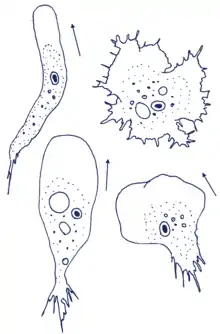Rhizamoeba
Rhizamoeba is a small genus of free-living marine naked lobose amoebae in the monotypic family Rhizamoebidae[1] in the order Leptomyxida.[2][3] It is most closely related to Leptomyxa and Flabellula, and some species have been moved to Leptomyxa due to molecular data.[1]
| Rhizamoeba | |
|---|---|
 | |
| Different monopodial shapes of Rhizamoeba (clockwise from top left): worm-like, static, flattened, clavate. | |
| Scientific classification | |
| Domain: | Eukaryota |
| Phylum: | Amoebozoa |
| Class: | Tubulinea |
| Order: | Leptomyxida |
| Family: | Rhizamoebidae |
| Genus: | Rhizamoeba Page 1972 em. Smirnov et al. 2016 |
| Type species | |
| Rhizamoeba polyura Page 1972 | |
| Species | |
Morphology
Members of Rhizamoeba are characterized by their morphology when they move, which is usually monopodial (with a single ramification), alternating between a slug-like shape and a fan shape. They have either one nucleus or multiple (less than 50) nuclei.[1]
Classification
The paraphyly of the genus caused the transfer of two previously rhizamoeban species into Leptomyxa: R. australiensis and R. neglecta. As a result, only 3 species are currently confirmed as Rhizamoeba:[1]
- Rhizamoeba saxonica Page 1974
- Rhizamoeba polyura Page 1972
- Rhizamoeba matisi Mrva in Smirnov et al. 2017
Other possible species are not yet confirmed due to lack of published data or poor documentation.[1] Some of these are: R. schnepfii Kühn 1996/97 (considered nomen dubium since it has not been deposited to any culture collection), Trichamoeba caerulea Schaeffer 1926 and Trichamoeba clava Schaeffer 1926 (both transferred to Rhizamoeba in 1980[4] but poorly documented), Amoeba clavarioides Penard 1902 (identified as R. clavarioides through light microscopy[5]), Polychaos timidum Bovee 1972 (identified as R. timidum through light microscopy[6]), etc.
References
- Smirnov, Alexey; Nassonova, Elena; Geisen, Stefan; Bonkowski, Michael; Kudryavtsev, Alexander; Berney, Cedric; Glotova, Anna; Bondarenko, Natalya; Dyková, Iva; Mrva, Martin; Fahrni, Jose; Pawlowski, Jan (2017). "Phylogeny and Systematics of Leptomyxid Amoebae (Amoebozoa, Tubulinea, Leptomyxida)". Protist. 168 (2): 220–252. doi:10.1016/j.protis.2016.10.006. ISSN 1434-4610.
- Tekle YI, Grant J, Anderson OR, et al. (April 2008). "Phylogenetic placement of diverse amoebae inferred from multigene analyses and assessment of clade stability within 'Amoebozoa' upon removal of varying rate classes of SSU-rDNA". Mol. Phylogenet. Evol. 47 (1): 339–52. doi:10.1016/j.ympev.2007.11.015. PMID 18180171.
- Smirnov AV, Nassonova ES, Cavalier-Smith T (February 2008). "Correct identification of species makes the amoebozoan rRNA tree congruent with morphology for the order Leptomyxida Page 1987; with description of Acramoeba dendroida n. g., n. sp., originally misidentified as 'Gephyramoeba sp.'". Eur. J. Protistol. 44 (1): 35–44. doi:10.1016/j.ejop.2007.08.001. PMID 17905574.
- Siemensma FJ (1980), "Amoeben", Natura, 77: 62–72
- Siemensma, Ferry J. (January 31, 2021). "Rhizamoeba clavarioides". Microworld, world of amoeboid organisms. Retrieved July 31, 2022.
- Siemensma, Ferry J. (January 31, 2021). "Rhizamoeba timidum". Microworld, world of amoeboid organisms. Retrieved July 31, 2022.